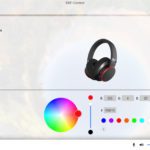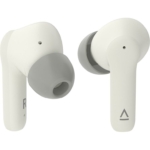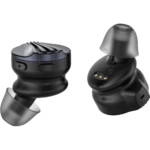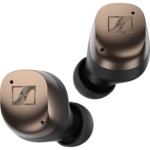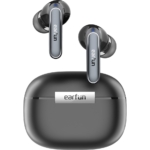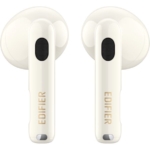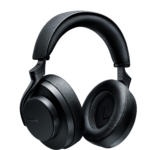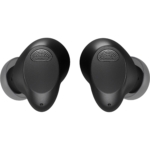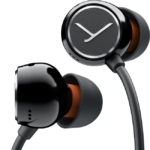It was somewhat difficult for me to judge the sound of these headphones comprehensively. The Creative SXFI Air sounds discreet and underwhelming in normal operation, falling more in the midrange. Certainly, when it comes to this mode of operation, there are cheaper available alternatives that deliver sound with a finer resolution and crisper transients. If you also consider the Super X-Fi function, evaluating these headphones becomes even more tricky. The resulting audio is too disparate, with pieces sounding too different, depending on the genre. Admittedly, telephoning with the technology enabled is great, while the 7.1 surround capabilities deliver a more immersive experience when watching movies or playing games.
What remains is a headphone that has implemented an exciting new piece of technology, with a slew of functions that work better in some instances than in others. If you’re interested in the technology on offer here, it’s definitely advisable to listen to the Creative SXFI Air over a longer period of time than the length of this test, allowing you to decide whether it fits with your own individual listening preferences and usage behaviour.
Imagine slipping on your headphones and enjoying sound as if it were coming from a high-end multi-speaker system in the recording studio, or as how it was recorded originally. Imagine being able to immerse yourself into audio with staggering levels of depth that showcases all that meticulous attention to detail that went into the original production. It might seem like a big ask and an unavailable innovation, but that’s exactly what Creative promises to deliver with its Super X-Fi technology. The company wants to make what they call “holographic sound” an experience for everyone. At a price of around 160 euros, such a promise sounds too good to be true.
Time for a Change?
Creative claims to have solved a significant problem with its Super X-Fi technology. They claim to have overcame the so-called one-dimensional, cramped sound staging that can compromise the listening experience as soon as we put on headphones and fire up audio. As this approach to listening to audio is in many ways against the principles of sound technology, thinking about listening quality in terms of “good headphone sound” is the wrong way to go. This is what Creative argues, anyway. To many, it might seem like bold talk, not least because everyone ultimately hears such audio differently. There’s numerous variables to consider in this respect, from the shape of the wearer’s ear to the size of their head. Of course, up until now, only the fit of the headphones themselves can accommodate such variables.
Wondering how Creative aim to solve this issue? Unlike other manufacturers that might utilise hearing tests and listening measurements, the company has turned to face scanning technology instead. This is the first step you’ll need to engage with in order to use the SXFI as intended. Firstly, the ears and face need to photographed with the use of a freely downloadable app. A quick tip here is to draft in the help of a second person, as this makes the photographing stage go much faster. You’ll also want to ensure you’re in a bright enough environment that the images provide enough detail for the appropriate analyses to be carried out.
To create an individual listening profile, you’ll first need to create an account with Creative. Once you’ve done this, you can upload your own photos and make them available to other devices. If you have any data protection concerns and are curious to know what exactly happens to your individual data, particularly those face photos, you’ll be somewhat disappointed. We couldn’t find any information discerning how long our images are stored for. The Creative server compares your personal photos with a database, utilising artificial intelligence to generate a sound mapping result that is specifically suited to you. It should be noted that once created, profiles can be used offline, with no internet connection required.
App Management
In principle, the app itself is straightforward and self-explanatory. In addition to the important photo function, the log-in and setup wizard, there’s also an option that outlines compatible headphones from other manufacturers. In theory, this means you can use your hearing profile with headphones from other brands. However, this will require the use of the SXFI Amp, a headphone amplifier designed for Android smartphones. If you still need to fine-tune your sound preferences, you can activate the equalizer and choose between five different presets. Alternatively, you can create a bespoke frequency curve yourself. What’s more, there’s also a music player available within the app, although it doesn’t work with the iPhone 6 or iPad 2017 models when trying to access playlists, at least when tested during our review. As such, you’ll want to block access to music libraries when you start the app for the first time with either of these devices. If you don’t, you can expect an immediate crash of your music library.
To confuse matters, there’s a second app, SXFI Air Control, available for Mac, iOS, Android and Windows devices. However, this app only offers two distinct functions which are tailored to the SXFI Air. Of note, this app is the only way for you to colour-match the LED elements of the headphones. It also allows you to download a firmware update. You can also activate Super X-FI sound and access an equalizer function. I did find myself wondering why the app needs to reconnect to the Creative headphones every time its called up, however. Even a simple unlocking of your phone will trigger this required reconnection.
Ultimately, both apps leave a mixed impression. Both look a little dated, with some minor translation issues also worth noting. They also don’t run completely reliably under iOS, while there’s a lack of further information available.
- The SXFI Control App start screen with macOS
- The Equalizer
- Here you can change the RGB colour settings
- Mode for switching between 5.1 and 7.1 Stereo
- The photo function of the SXFI App
- Menu overview of the SXFI App
- Function overview of the SXFI Air Control App
- Menu overview of the SXFI Air Control App
The Hardware
No to be disheartened by these minor app niggles, we put the headphones on. Coming in at a reasonable 340 grams, the SXFI Air isn’t the lightest headphone model out there, but considering the amount of technology within, it’s hardly surprising. The weight, however, is barely noticeable when you’ve got the headset on. What is noticeable though, is the contact pressure. After around 30 minutes of wearing them, I had to take them off to give my ears a break. When it comes to the manufacturing of the SXFI Air, there’s little to fault. Things are clean and visually appealing, even with a predominantly plastic construction. Next to the power button there’s the Bluetooth switch, the Super X-FI switch, a microSD card slot enabling playback for MP3, WMA, WAV and FLAC, along with a mini microphone on the left earpiece. Thanks to the touch panel earpiece, calls can be easily accepted or rejected, playback volume can be adjusted, while there’s also the option to skip back and forth between tracks. All other touch gestures performed perfectly during our test, without any noticeable response delays.
Convenient Connection
Creative has provided plenty of connection possibilities here. These over-ears can be operated via Bluetooth 4.2 (unfortunately, only with SBC codec), as well as via analogue mini jack cable. Additionally, connection is possible via USB-C to A cable.
Successful pairing is confirmed by a clear female voice, while the Bluetooth button allows you to switch readily between Bluetooth, USB and microSD card modes.
Sound
How does the SXFI Air perform in terms of music, movie and gaming playback? Firstly, we pitted these over-ears against our Spotify Playlist. The SXFI Air handled things quite well, although the stage isn’t very wide, but this isn’t all that unusual for closed headphone systems. Ultimately, there’s not too much to complain about when listening in normal operation, although some background noise is noticeable upon first use. This isn’t really an issue when you’re listening to electronic tracks and louder rock and pop numbers, but during quieter music passages and classical productions, it can present itself as something of a distraction.
Next, we decided to see how well the Super X-Fi technology delivers in terms of holographic sound. The initial listening impression is at first a little jarring, due to the fact things sound somewhat diffused and a little cloudy. It quickly becomes apparent that not all tracks are suited to playback in SXF-i mode. For example, with rap music there’s a significant reduction in bass. Generally speaking, things are reminiscent of a live performance or jam session within the recording studio. This isn’t without its charms, with some percussion given a more playful character. When it comes to jazz or orchestral arrangements, you definitely get the feeling of standing right in front of the musicians themselves. If it weren’t for the aforementioned background noise problem causing an issue when listening at lower volumes, it would be top marks here. On a final note, the Super X-Fi technology also doesn’t lend itself well to singer-songwriter compositions, with the immersive resolution proving a little too much for our liking. The artificially created sense of naturalness doesn’t always prove a good fit, although it’s worth judging for yourself on an individual track basis.
When it comes to judging these headphones in terms of pure music consumption, it has to be said the SXFI Air plays rather discreetly in normal mode. However, the holographic technology does give us an interesting impression of how individual pieces can sound. That being said, this can be welcome or unwanted, depending on the source media.
Next we’ll focus on the surround sound aspect of things, especially when it comes to movies and gaming applications. You can certainly look forward to a more immersive experience with the SXFI Air. When watching Spiderman, the famous web-slinger swings through his environment with a sense of three-dimensionality, with details nicely distributed in the virtual space. The same is true when gaming via USB. When playing Fortnite on the PS4, we could hear opponents approaching from behind, allowing us to react quickly and gain an upper hand in advance.
Technical specifications
- Ear couplingOver-ear
- Typeclosed
- Transducer principledynamic
- Frequency response (headphones)20 - 20.000 Hz
- Weight with cable381 g
- Weight without cable342 g
What's in the box
- Mini jack cable
- USB C to A charging cable
Special features
- Available in black and white
- Interface: USB, Bluetooth, 3.5mm stereo input, microSD card (up to 32GB, FAT32)
- BT version: 4.2
- BT codec: SBC
- RGB earrings: up to 16 million colors selectable
- Apps for Mac, Windows, iOS, Android









